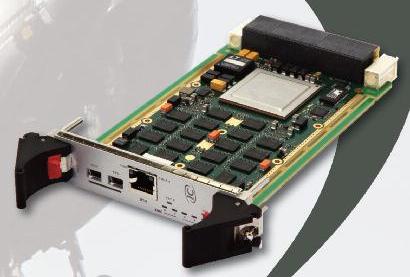
4 minute read
Interface Concept - High Performance Ethernet Redundancy Solution
High performance Ethernet redundancy solution
for the Industrial and Defense markets

Today’s defense systems are highly sophisticated and based on high-performance mission computers, servers, workstations and signal processing nodes that need to exchange large amounts of information.

This critical and strategic information is transmitted via communication networks requiring high availability, reliability and robustness. In these systems, where Ethernet is ubiquitous, the network infrastructure and communication protocols must ensure that no data gets lost and that information is reliably delivered. To meet these requirements in the most critical conditions, a solution to consider is the implementation of a redundancy network.
THE CHALLENGES
In parallel with the rapid deployment and growing popularity of Gigabit Ethernet standard, that is not deterministic by essence, network redundancy protocols such as Parallel Redundancy Protocol (PRP) and High-availability Seamless Redundancy (HSR) have been developed to overcome network failures.
However, introducing communication robustness to embedded military systems means adding a constraint to this area already subject to quite a few, the main ones being to maintain even continuously improve performance, ensure interoperability and reduce costs.
THE SOLUTION
As a result, most integrators and users in the Defense, tend to upgrade their VME and VPX systems with a high-performance redundancy module. In this respect, Interface Concept has leveraged its knowledge in the defense systems and extensive experience in Ethernet technology, to provide the market with the IC-RBP-XMCa. The IC-RBP-XMCa, an FPGA XMC (Switched Mezzanine Card) board offers an outstanding solution to the above requirements. The on-board FPGA makes the board versatile, supporting both PRP and HSR redundancy protocols, as a redbox :
PRP: Parallel Redundancy protocol network
Equipment 1 IC-RBP-XMCa Equipment 2
Ethernet Network A Ethernet Network B
Equipment 3 IC-RBP-XMCa IC-RBP-XMCa Equipment 4
When operating in PRP mode, several IC-RBP-XMCa cards are attached to two separate networks via two distinct Ethernet interfaces. Each ICRBP-XMCa card is also connected to a Single Attach Node (SAN) or equipment which receives/transmits normal (non-duplicated) traffic. When transmitting frames towards the network, the IC-RBP-XMCa card forwards the frames coming from the SAN on each network. When receiving frames from the redundant network, the IC-RBP-XMCa forwards the frames arriving first to the SAN and discards the duplicate frames. In case of a failure in one of the network links, the redundant network allows the remaining operating network to continue to seamlessly provide traffic to the attached equipment.
HSR: High-availability Seamless Redundancy
Equipment 1 IC-RBP-XMCa Equipment 2

When operating in HSR mode, several IC-RBP-XMCa cards operate in a similar way but with a ring topology network. In this case, each IC-RBPXMCa board stands at each node of the ring and is capable of duplicating traffic towards both directions of the ring when transmitting frames and discards duplicates when receiving frames.
WHY USING THE IC-RBP-XMCa ?
5 R J 4 1 L
R J 4 5 0 L
R J 4 5 B
5 R J 4 A Eth

DDR4
32 bits + ECC QSPI mirror
Config. flash
1G QUAD PHY
QSGMII
mdc /mdo ZYNQ FPGA
DDR4
32 bits QSPI mirror
(User/OS Flash)
RS232 / RS4222
12C
Control node
SERDES/ 1000BASE-X
Intel 1210
x1
Mux ctrl
x2
PCIe mux PCIe
x2
Power and T° monitoring
DC/DC converters P6
P5
IC-RBP-XMCa block diagram - Active network redundancy XMC Switch Mezzanine Card
1/ The FPGA turns out to be very efficient in applications requiring low latency, which offers an outstanding solution to the redundant communication systems performance requirements.
2/ Besides, whether it be redundancy with PRP or HSR protocol, it is essential to be able to manage the redundant networks, and from a software standpoint, a monitoring application accessible via the IC-RBPXMCa’s Ethernet ports provides the user with network statistics and status and can be used to generate real-time events such as the loss of a network link. • The FPGA allows it to be optimal in terms of performance and latency delay. It also allows the board to support independently PRP and HSR protocols on Giga Ethernet networks. • The ARM processor integrated to the MPSoC, enables the user to access monitoring and control functions, while the board is being turned on. • Its XMC mezzanine form-factor (VITA 42) makes the board a versatile DAN that can be integrated in any system type and on any carrier or Single Board Computer type. • This board has been qualified to meet environment requirements in the embedded market, and is available for air-cooled systems and conduction-cooled systems.


In light of this, hybrid chips, like Xilinx Zynq® architectures, which integrate ARM processors as well as programmable logic in a single System-On-a-Chip (SoC), find all its meaning and allow to deal with both the required determinism by the function and to provide an answer to the microprocessor need with regard to the control.
The IC-RBP-XMCa supports an internal Ethernet switch for several SAN ports to allow easy systems connection to redundant networks.
The IC-RPB-XMCa has been developed to meet all redundant communication network requirements. In the light of the above characteristics, the IC-RBP-XMCa is definitively a high-performance, reliable, versatile and cost-effective solution.
This mezzanine card, equipped with a Xilinx MPSoC, namely a Zynq T: +33 (0)2 98 57 30 30 E: info@interfaceconcept.com










